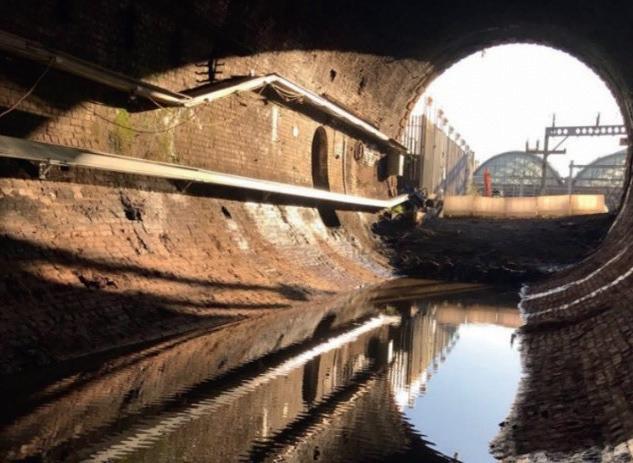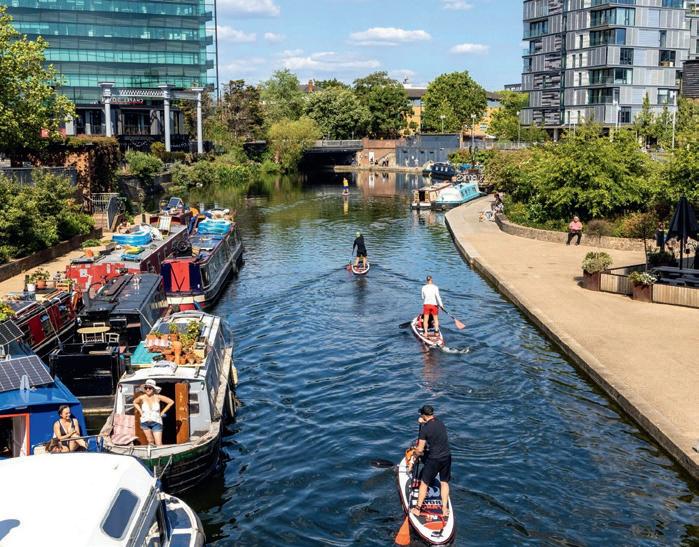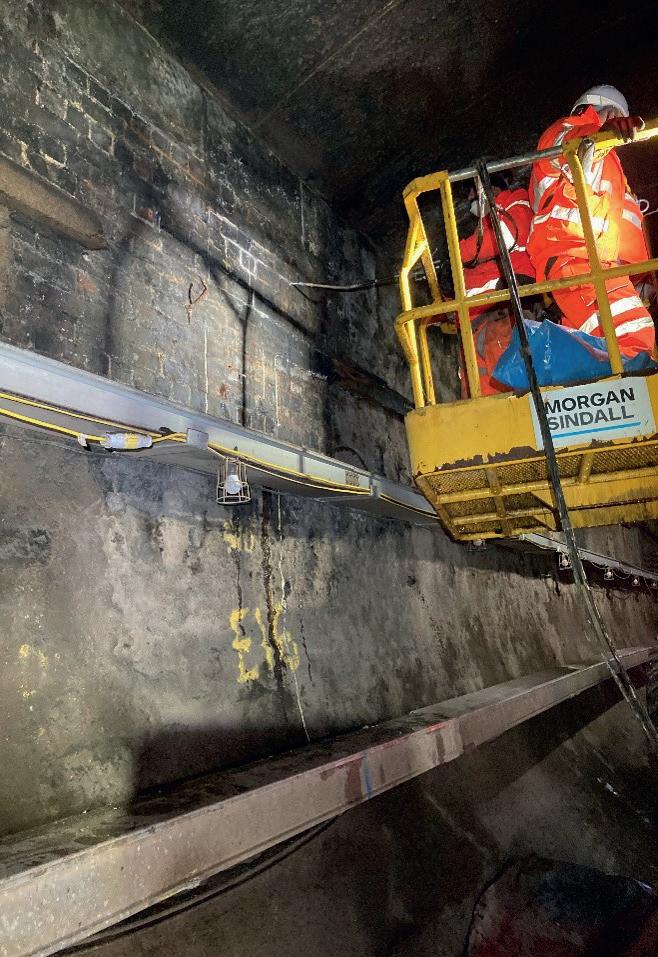
6 minute read
Tunnelling
Tunnel water management
From November 2020 to February this year, Morgan Sindall carried out restorative works on the East Bore of Gasworks Tunnel at King’s Cross Train Station
The Gasworks Tunnel is a set of three parallel railway tunnels which serve trains on the East Coast Mainline on the approach (and departure from) King’s Cross Station and are located under Regent’s Canal (shown below). The Eastern Bore of the tunnel was built in 1892 and subsequently taken out of use in 1977 during a large remodelling of the station and its track layout.
As part of the ongoing King’s Cross remodelling project for Network Rail, extensive improvement works have been undertaken to allow the third tunnel bore to be reinstated. The project is to provide two additional tracks on the approach to the station, ultimately resulting in more capacity and a greater flexibility for services coming in and out of King’s Cross.
Works to reinstate the East Bore Overhead Line Equipment and supporting infrastructure has now been installed into the brick lining of the tunnel. The tunnel had suffered from significant water ingress through the old brickwork and joints over the many years. In order to facilitate the installation and ensure the system would continue to be safe, secure and well maintained, it was imperative to manage the water coming through the assets

brickwork away from the OLE equipment. The plan involved injecting a combination of waterproofing and refurbishment materials into the crown and shoulder of the tunnel intrados at multiple OLE locations to consolidate the bricks and push water away from the key locations.
The project was self-delivered by Morgan Sindall for the client, Network Rail, using ASF Waterproofing as the specialist subcontractor carrying out the injection works.
The photos below show the condition of the East Bore of Gasworks Tunnel before any works commenced with King’s Cross in the background.
Design The designs were drawn up by Tony Gee & Partners on behalf of Morgan Sindall to set out the extent of the waterproofing and the specific locations within the tunnel. The new OLE infrastructure is shown in purple and the example waterproofing area in yellow.
Materials selection Morgan Sindall have played a major role on many major tunnelling projects over the years, and has worked very closely with key suppliers, one of which is Master Builders Solutions who supply specialist construction chemicals to the industry. After several meetings and a site visit to establish specific refurbishment criteria, details of products were proposed to form a system approach to the issues.
Master Builders Solutions then carried out product demonstrations in the plant yard to main Contractor, Designer and Client. Following the demo/trial it was agreed that MasterRoc MP368 Tix, MasterRoc MP 307 CE & MasterRoc MP 320 would be taken forward for further trials within the tunnel.
Methodology The tunnel has only ever seen steam trains running through it, so the first job was to remove the considerable soot deposits from the crown of the tunnel. At the same time, it was necessary to rake out and reinstate the mortar joints with historic mortar mix.
In situ trial patches of the clearly defined water management plan were conducted by ASF Waterproofing and supported by Master Builders Solutions to confirm suitability in the works. The results of the trials indicated that two materials, MasterRoc MP 307 CE & MP 368 Tix should be used to complement each other. MasterRoc MP 368 Tix (a thixotropic two component polyurea silicate resin) would be injected to fill any voids within the tunnel’s brickwork lining. The high bond to substrate also provided a structural repair to the OLE fixing zone. Its thixotropic characteristics enabled easy overhead injections, provided control on where the material travelled whilst ensuring minimal waste or mess in the tunnel.
MasterRoc MP 307 CE (a low viscosity acrylic resin) was injected to permeate the brickwork lining and mortar joints, creating a permanent, resilient waterproofed area in that prescribed section as required by the design. The products adjustable gel time helped control the travel of the resin, and the in-situ trial demonstrated the spread of material allowing the injection centres to be set for each of the zones to be treated.
There were in total 28no. different designated zones along the tunnel which required water management treatment. All of which were located in the crown and shoulder of the tunnel, so PASMA scaffold towers and Mobile Elevated Work Platforms (MEWPs) were utilised by the
injection team to gain safe and flexible access to the work area and to reduce any disruption to other operations. 400mm long drill bits were used to drill into the joints in the brickwork along the newly placed mortar to minimise disruption to the face of the brickwork (and cut down on any remedials).
The depth of injection was chosen to ensure that the total brickwork lining (approximately 600mm) would be treated, optimising the flow into the brick layers and joints thereby increasing effectiveness of the materials in-situ without wastage to the exterior face of the structure.



Once the holes were drilled and cleaned out, 10mm mechanical steel packers were installed in a grid formation around each of the OLE fixings. ASF Waterproofing used both two and three component injection pumps to inject the MasterRoc injection resins into the substrate. Since neither product expands (or shrinks) once cured, there was no excessive pressure exerted on the brick lining.
Once the injections were complete packers were removed and the holes left were filled with new historic mortar.
The volume of material taken at each location varied according to the state of the brickwork and joints, and whilst it is not possible to anticipate volume required, it can be stated that the overall quantity of material was proportionate to the task, and much less than alternative approaches. For example – fluid cementitious options with bulky mixing plant, injected and flowing beyond the structure with no control of setting characteristics – messy with a lot of waste. Conclusions Overall, the works to manage water in the tunnel proved extremely successful and as a result the tunnel now looks much drier, and the tunnel lining reinforced in the treated zones. The challenges along the way were many and varied. The negative impact of temperature in the tunnel, Covid-19, and Brexit all combined to make every stage of the project very demanding.
The multiple disciplines working at the same time in the tunnel required close supervision and planning, but this system proved to be the least disruptive to the structure and the work sequence, with flexibility in application to allow good progress in a tight programme.
All OLE fixings are now installed within the tunnel and locations have been inspected – they remain dry despite recent wet weather.

Email: Richard.foord@mbcc-group.com Master Builders Solutions: https://www. master-builders-solutions.com/en-gb/solutions/ for-the-tunneling-industry Project: https://www.networkrail.co.uk/ running-the-railway/our-routes/east-coast/ east-coast-upgrade/kings-uncrossed











